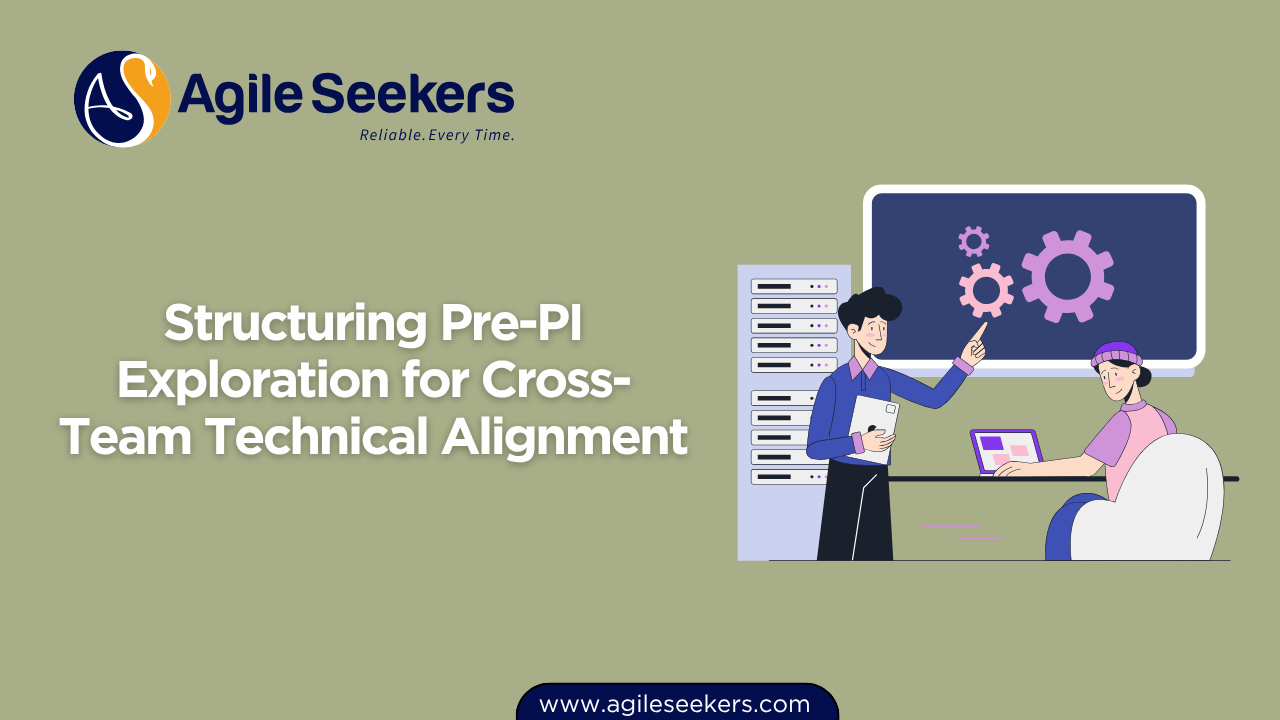Structuring Pre-PI Exploration for Cross-Team Technical Alignment

Before a PI Planning session begins, many Agile Release Trains (ARTs) face challenges aligning on complex architectural and technical dependencies across teams. If unresolved, these challenges can lead to misaligned objectives, redundant efforts, or quality issues downstream. Structuring a robust pre-PI exploration helps synchronize teams and system architects before entering the cadence-based planning cycle.
This post outlines actionable steps for organizing pre-PI activities focused on technical discovery, interface alignment, and architectural readiness. It highlights how SAFe POPM Certification holders play a key role in this process and provides practical guidance to foster smoother planning and execution cycles.
Why Pre-PI Exploration Matters
ARTs often face technical misalignment not because of poor execution but due to a lack of structured discovery ahead of the PI Planning event. Pre-PI exploration allows teams to:
- Uncover architectural dependencies and data contract issues.
- Align on system enablers and interface definitions.
- Clarify solution intent and shared technology strategies.
- Co-develop architectural runway items.
- Coordinate on sequencing and prioritization of cross-team work.
Without this upfront exploration, teams risk starting PI Planning with only partial clarity—leading to cascading delays and scope churn across the ART.
Key Roles Driving Pre-PI Exploration
Several roles contribute to technical alignment during this phase:
- System Architects: Define and communicate enablers and evolving architecture needs.
- Product Managers: Connect business context to technical priorities and ensure enablers are appropriately scoped.
- RTEs: Facilitate coordination events and support ART readiness checklists.
- Product Owners: Represent team-level concerns and bring early feedback from backlog refinement sessions.
Those trained through SAFE Product Owner/Manager certification programs are better equipped to contribute during pre-PI phases due to their training in backlog prioritization, enabler understanding, and inter-team coordination.
Structuring Effective Pre-PI Activities
Let’s walk through a structured approach to pre-PI exploration that drives meaningful alignment across teams:
1. Conduct Enabler Discovery Sessions
System Architects should lead early sessions to identify new enabler features, capabilities, or stories needed to support solution evolution. Involving representatives from each team ensures that technical risks, refactoring needs, and dependency areas are surfaced early.
For example, if a team is integrating a new identity service, they should clarify expected APIs, token formats, and handshake mechanisms during pre-PI discussions—not during the PI Planning event. Resources like SAFe’s guidance on enablers help structure these discussions.
2. Map Inter-Team Technical Dependencies
Use dependency mapping techniques like dependency boards or tools such as Jira Align to visualize inter-team deliverables. Capture upstream/downstream handoffs, service integrations, and shared infrastructure dependencies.
This mapping should be iterative and involve Product Owners and technical leads. It’s also where SAFe Popm training helps by equipping professionals to identify and prioritize cross-team blockers early.
3. Align Solution Intent with Teams
Clarifying the shared understanding of Solution Intent helps standardize how features are expected to work technically. If the Solution Intent includes accessibility standards or data retention policies, teams should address implementation strategies during pre-PI meetings.
This ensures consistent implementation across ARTs and avoids divergence. Reference frameworks like SAFe’s Solution Intent page to guide the conversation.
4. Host Technical Design Reviews
Technical spikes and architectural runway items should be reviewed collectively before planning. This prevents duplication and brings reusability into the picture. Include DevSecOps engineers, infrastructure specialists, and data engineers where relevant.
Consider assigning a tech steward to each cross-team capability. This person serves as the point of contact for coordination and tech resolution prior to PI Planning.
5. Validate Readiness with a Pre-PI Checklist
A structured checklist can help validate the ART’s readiness to enter PI Planning:
- Are all critical enablers defined and estimated?
- Have dependencies been logged and mapped?
- Is the Solution Intent understood across teams?
- Have high-risk interfaces been discussed and designed?
- Are key architectural decisions documented?
Readiness checklists bring discipline and reduce surprises during planning. This activity complements the ongoing work Product Managers and Product Owners do when trained through SAFE Product Owner Certification programs.
When to Start Pre-PI Exploration?
Start exploration at least 2–3 weeks before the PI Planning event. This gives teams enough time to iterate on enablers, engage with architects, and participate in joint reviews. Product Owners should start pre-refining their backlogs in parallel, adjusting priorities based on what emerges from cross-team discussions.
Common Pitfalls and How to Avoid Them
- Lack of time-boxing: Don’t let pre-PI discussions drag. Time-box each session with a clear agenda and outcome.
- Over-centralization: Empower teams to self-organize while providing system-level guidance.
- Ignoring historical learnings: Review past PI retrospectives to address recurring technical issues before they repeat.
Final Thoughts
Pre-PI exploration is not optional—it's a critical part of building a resilient and aligned ART. Teams that invest time into structured exploration before planning consistently report fewer reworks, better capacity planning, and improved delivery alignment.
Product Owners and Managers certified through SAFe Product Owner/Manager certification are trained to champion these early alignment efforts and bridge the technical and business domains effectively.
For deeper insights on structuring ARTs and aligning at scale, explore thought leadership from Scaled Agile Framework (SAFe) and proven techniques from Martin Fowler on scaling agile.
Also read - Tracking Technical Debt and Refactoring via PI Planning Outputs
Also see - Managing Technical Complexity in Backlogs Using Capacity Allocation




















